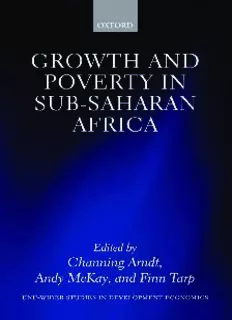
Growth and Poverty in Sub-Saharan Africa PDF
Preview Growth and Poverty in Sub-Saharan Africa
Growth and Poverty in Sub-Saharan Africa United Nations University World Institute for Development Economics Research (UNU-WIDER) was established by the United Nations University as its first research andtrainingcentreandstartedworkinHelsinki,Finland,in1985.Themandateofthe institute is to undertake applied research and policy analysis on structural changes affectingdevelopingandtransitionaleconomies,toprovideaforumfortheadvocacy ofpoliciesleadingtorobust,equitable,andenvironmentallysustainablegrowth,andto promote capacity strengthening and training in the field of economic and social policymaking. Its work is carried out by staff researchers and visiting scholars in Helsinkiandvianetworksofcollaboratingscholarsandinstitutionsaroundtheworld. UnitedNationsUniversityWorldInstituteforDevelopmentEconomicsResearch (UNU-WIDER) Katajanokanlaituri6B,00160Helsinki,Finland www.wider.unu.edu Growth and Poverty in Sub-Saharan Africa Edited by Channing Arndt, Andy McKay, and Finn Tarp AstudypreparedbytheUnitedNationsUniversityWorldInstitute forDevelopmentEconomicsResearch(UNU-WIDER) 1 OUPCORRECTEDPROOF–FINAL,10/2/2016,SPi 3 GreatClarendonStreet,Oxford,OX26DP, UnitedKingdom OxfordUniversityPressisadepartmentoftheUniversityofOxford. ItfurtherstheUniversity’sobjectiveofexcellenceinresearch,scholarship, andeducationbypublishingworldwide.Oxfordisaregisteredtrademarkof OxfordUniversityPressintheUKandincertainothercountries ©UnitedNationsUniversityWorldInstituteforDevelopmentEconomicsResearch (UNU-WIDER)2016 Themoralrightsoftheauthorshavebeenasserted FirstEditionpublishedin2016 Impression:1 Somerightsreserved.Thisisanopenaccesspublication.Exceptwhereotherwisenoted, thisworkisdistributedunderthetermsofaCreativeCommonsAttribution-Non Commercial-ShareAlike3.0IGOlicence(CCBY-NC-SA3.0IGO),acopyofwhich isavailableathttps://creativecommons.org/licenses/by-nc-sa/3.0/igo/. Itispermittedtoreuse,shareandadaptthiswork,subjecttothefollowingterms: Attribution-appropriatecreditisgiventotheoriginalwork,thecopyrightholderand creator,andanychangesmadetotheworkareproperlyindicated. Non-Commercial-thework,oranyadaptationofthework,maynotbeused,distributed orreproducedinanyformat,byanymeans,forcommercialpurposes. Share-Alike-thework,oranyadaptationoftheworkisdistributedunderthesamelicence termsastheoriginal,withaURLlinkprovidedtothelicence. EnquiriesconcerninguseoutsidethetermsoftheCreativeCommonslicenceshould besenttotheRightsDepartment,OxfordUniversityPress,attheaboveaddressorto [email protected]. PublishedintheUnitedStatesofAmericabyOxfordUniversityPress 198MadisonAvenue,NewYork,NY10016,UnitedStatesofAmerica BritishLibraryCataloguinginPublicationData Dataavailable LibraryofCongressControlNumber:2015949595 ISBN 978–0–19–874479–5 PrintedinGreatBritainby ClaysLtd,StIvesplc LinkstothirdpartywebsitesareprovidedbyOxfordingoodfaithand forinformationonly.Oxforddisclaimsanyresponsibilityforthematerials containedinanythirdpartywebsitereferencedinthiswork. Foreword Despite decades of research and advances in data and methodologies, meas- uring poverty and reconciling this with patterns of economic growth is a disputatious issue. This contentiousness and the fact that poverty remains widespread in sub-Saharan Africa (SSA) charged UNU-WIDER to launch in 2011 a major research project—the Growth and Poverty Project (GAPP)—to re-examine SSA’s growth, poverty, and inequality trends with three main goals in mind. First, develop new tools to measure monetary poverty in consistentandcomparableways,andmakethesetoolsaccessibletoscholars andanalystsinAfrica,otherdevelopingregions,andbeyond.Second,under- takedetailed case studiesof sixteenof the twenty-four mostpopulouscoun- triesinSSA(coveringnolessthan73.8percentofthepopulationinSSA)to measurepovertytrends,and‘triangulate’thesewithotherdevelopmentindi- cators. Third, develop a macro–micro analytical framework to conduct detailed research in countries where poverty and economic growth trends appeartobeinconsistent. This book holds the essential country-level harvest of this large, multi- country, multi-discipline research project brought to the reader in a con- densed form together with a comprehensive synthesisto explore the depths oftheunfoldingstoryofthegrowth–povertynexusinSSAandtoabsorbthe policy implications. The project team consisted of leading international expertsandUNU-WIDERresearchersalongwithsomeoftheAfricancontin- ent’sbestresearchersanddataanalysts.Iherebysincerelyexpressmyappre- ciationandadmirationoftheacademicandanalyticalskillsofthisteamand the detailed knowledge of the case countries brought out so clearly in this volume.Ourprofessiondoesindeedhavesomethingsensibletocontribute— both in recognizing that growth is in many cases translated into poverty reductioninAfricancountriesandinhelpingtounderstandwhythislinkis sometimesnotasrobustasdesirable. UNU-WIDERgratefullyacknowledgestheSpecialProgrammeContribution (SPC) by the Ministry of Foreign Affairs of Finland for this project and the regularcorefinancialcontributionsmadetoitsresearchprogrammefromthe governmentsofDenmark,Finland,Sweden,andtheUnitedKingdom. FinnTarp Helsinki,January2016 Acknowledgements UNU-WIDER’sGrowthandPovertyProject(GAPP)wasimplementedbetween 2012 and 2014 and brought together a highly qualified team of more than fortyresearchersfromAfricaandbeyond.Withouttheirdedicationandpro- fessional competence, this book would not have been possible. We wish to express our sincere appreciation to these country teams who produced the casestudiesinthisbook.Puttingtogetheravolumesuchasthisoneisnoeasy undertaking;andwewishtoexpressourappreciationforallofthehigh-level academic input, together with the copious goodwill and patience—which weremuchneededwhendoingtheoriginalgroundworkfollowedbynumer- ousrevisionsandupdatesoftheindividualchapters. A series of intensive planning meetings, involving many of the authors, helped shape the project; and results were presented at several UNU-WIDER developmentconferencesandmanyotheroccasionsacrossAfricancountries. We are grateful to all of those who offered critique and most helpful com- ments. They include Oxford University Press’s Economics Commissioning Editor Adam Swallow and his team, as well as three anonymous referees. Your efforts were essential in helping to sharpen our research questions and approachtoaddressingoneofthemostintricatechallengesfacingthedevel- opmentprofession,theAfricangrowthrenaissanceanditsimpactonpoverty reduction. UNU-WIDER and its dedicated staff provided steady support, including researchassistance,whichgoesfarbeyondthenormalcallofduty.Particular thanks go to Dominik Etienne for excellent programming; Anne Ruohonen forconsistentprojectassistance;LorraineTelfer-Taivainenforallofthecareful publicationsupport,includingthemanycontactswithOUP;andLisaWinkler andthegroupofcopy-editorsforhelpingtoputoutthemanyUNU-WIDER workingpapersproducedduringthecourseoftheproject. Theresearchproject—ReconcilingAfrica’sGrowth,Poverty,andInequality Trends—wasgenerouslysupportedbythegovernmentsofDenmark,Finland, Sweden, and the United Kingdom, with a special project contribution add- itionally provided by the Finnish government. UNU-WIDER gratefully acknowledgesthisvitalresearchfunding.Itisourhopethatthevolumewill beofrelevancetoallofthosestrugglingtoendpovertyinAfrica. ChanningArndt,AndyMcKay,andFinnTarp Helsinki,January2016 Contents ListofFigures xi ListofTables xv ListofBoxes xxi ListofAbbreviations xxiii NotesonContributors xxvii 1. GrowthandPovertyinSub-SaharanAfrica 1 ChanningArndt,AndyMcKay,andFinnTarp 2. Synthesis:TwoCheersfortheAfricanGrowthRenaissance (butnotThree) 11 ChanningArndt,AndyMcKay,andFinnTarp Part1.RapidGrowthandRapidPovertyReduction 3. PovertyinEthiopia,2000–11:WelfareImprovementsina ChangingEconomicLandscape 43 DavidStifelandTassewWoldehanna 4. Ghana:PovertyReductionoverThirtyYears 69 AndyMcKay,JukkaPirttilä,andFinnTarp 5. DidRapidSmallholder-LedAgriculturalGrowthFailtoReduce RuralPoverty?MakingSenseofMalawi’sPovertyPuzzle 89 KarlPauw,UlrikBeck,andRichardMussa 6. Growth,PovertyReduction,andInequalityinRwanda 112 AndyMcKayandMarijkeVerpoorten 7. PovertyanditsDynamicsinUganda:ExplorationsUsing aNewSetofPovertyLines 137 BjornVanCampenhout,HarunaSekabira,andDedeHoueto Aduayom Part2.RapidGrowthbutLimitedPovertyReduction 8. BurkinaFaso:ShippingaroundtheMalthusianTrap 163 MichaelGrimm,ClaudeWetta,andAudeNikiema
Description: